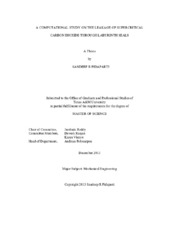| dc.description.abstract | To meet future energy needs the use of alternative fuel sources are gaining popularity. The supercritical carbon dioxide Brayton cycle has been proposed as a possible cycle for next generation nuclear and concentrated solar power generation. Large density fluctuations of carbon dioxide in the supercritical region can be exploited to maintain compressor inlet conditions close to the critical point and thereby, reducing the compressor work and the back work ratio. In order to improve the efficiency of turbomachinery equipment it is important to reduce internal leakage through seals.
A computational study was performed to understand the leakage through seals subject to large pressure differential using Open source CFD software OpenFOAM. FIT (Fluid Property Interpolation Tables) program is implemented in OpenFOAM to accurately model the properties of CO_(2) required to solve the governing equations. To predict flow behavior in the two phase dome HEM (Homogeneous equilibrium model) is assumed to be valid. Effects of geometrical parameters and operating conditions are isolated from each other and a parametric study was performed in two parts to understand the effects of both geometrical parameters and operating conditions.
Results of the geometrical parameter study indicated that the carryover coefficient of a seal is independent of pressure drop across the seal and is only a function of geometry. A model for carryover was developed as a function of c/s (clearance to pitch ratio) and w_(cavity)/c (cavity width to clearance). It has been identified that the major non-dimensional parameter influencing the discharge through an annular orifice is w_(tooth)/c (tooth width to clearance) and a model for Cd (discharge coefficient) can be developed based on the results we obtained. Flow through labyrinth seals can be considered as a series of annular orifices and cavities. Using this analogy, leakage rate equations can be written for each tooth and the mass flow rate can be modeled as a function of the discharge coefficient under each tooth and the carryover coefficient, which accounts for the turbulent dissipation of kinetic energy in a cavity. The discharge coefficient of first tooth in a labyrinth seal is similar to that of an annular orifice, whereas, the discharge coefficient of the rest of the tooth was found to be a function of the C_(d) of the previous tooth and the carryover coefficient.
To understand the effects of operating conditions, a 1-D isentropic choking model is developed for annular orifices resulting in upper and lower limit curves on a T-s diagram which show the choking phenomenon of flow through a seal. This model was applied to simulations performed on both an annular orifice and a labyrinth seal. It has been observed that the theory is, in general, valid for any labyrinth seal, but the upper and lower limit curves on a T-s diagram depend on number of constrictions. As the number of constrictions increases these two curves move farther away from the critical point.
Finally, some experimental results for a plain orifice (L/D ~ 5) were used to show the capabilities of the FIT model implemented in OpenFOAM. Error analysis indicated that OpenFOAM is capable of predicting experimental data within a 10 % error with the majority of data close to a 5 % error. This validates the FIT model and HEM assumption. | en |


